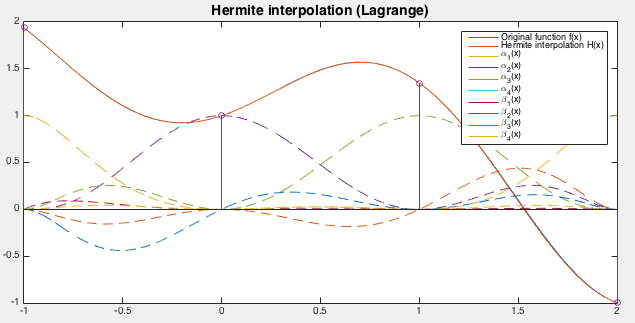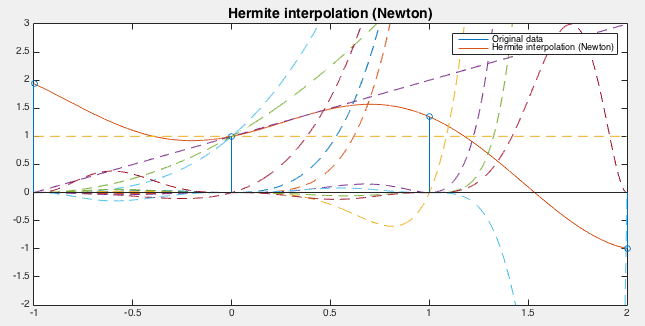Next: Cubic Spline Interpolation Up: Interpolation and Extrapolation Previous: The Newton Polynomial Interpolation
If the first 






 |
(46) |
 coefficients
coefficients
 could be obtained by solving a linear equation
system of the same number of equations:
could be obtained by solving a linear equation
system of the same number of equations:
 |
(47) |
 .
.
In practice, the Hermite interpolation can be used in such a
case. First, we assume 




 |
(48) |
 to satisfy
to satisfy
 and
and
 (
(
 ), the basis polynomials must satisfy:
), the basis polynomials must satisfy:
 |
(49) |
 satisfies
satisfies
 , we let the basis polynomials of degree
, we let the basis polynomials of degree
 take the following forms:
take the following forms:
 |
(50) |
 and
and  for
for
 and
and
 to satisfy the following when
to satisfy the following when
 :
:
 |
(51) |
 and and |
(52) |
 |
(53) |
 |
 |
 |
|
 |
 |
||
 |
![$\displaystyle \sum_{i=0}^n\left[f(x_i)+(x-x_i)(f'(x_i)-2f(x_i)l'_i(x))\right]\;l_i^2(x)$](img247.svg) |
(54) |
Example
The Hermite interpolation is carried out to the same function











The Matlab code that implements the Hermite interpolation method is listed below.
function [H a b]=HIL(u,x,y,dy) % Hermite interpolation (Lagrange)
% u: discrete data points;
% vector x: [x_1,...,x_n]
% vector y: [y_1,...,y_n]
% vector dy: [y'_1,...,y'_n]
n=length(x); % number of interpolating points
k=length(u); % number of discrete data points
li=ones(n,k); % Lagrange basis polynomials
a=zeros(n,k); % basis polynomials alpha(x)
b=zeros(n,k); % basis polynomials beta(x)
H=zeros(1,k); % Hermie interpolation polynomial H(x)
for i=1:n
dl=0; % derivative of Lagrange basis
for j=1:n
if j~=i
dl=dl+1/(x(i)-x(j));
li(i,:)=li(i,:).*(u-x(j))/(x(i)-x(j));
end
end
l2=li(i,:).^2;
b(i,:)=(u-x(i)).*l2; % basis polynomial alpha(x)
a(i,:)=(1-2*(u-x(i))*dl).*l2; % basis polynomial beta(x)
H=H+a(i,:)*y(i)+b(i,:)*dy(i); % Hermite polynomial H(x)
end
end
We next consider the case when 






 |
(55) |
This function 



 |
 |
![$\displaystyle f(z_0)+\sum_{i=1}^8 f[x_0,\cdots,x_i]\prod_{j=0}^{i-1}(x-x_j)$](img262.svg) |
|
 |
+f[z_0,z_1,z_2](x-z_0)(x-z_1)$](img263.svg) |
||
(x-z_1)(x-z_2)$](img264.svg) |
|||
(x-z_1)(x-z_2)(x-z_3)$](img265.svg) |
|||
(x-z_1)(x-z_2)(x-z_3)(x-z_4)$](img266.svg) |
|||
(x-z_1)(x-z_2)(x-z_3)(x-z_4)(x-z_5)$](img267.svg) |
|||
(x-z_1)(x-z_2)(x-z_3)(x-z_4)(x-z_5)(x-z_6)$](img268.svg) |
|||
(x-z_1)(x-z_2)(x-z_3)(x-z_4)(x-z_5)(x-z_6)(x-z_7)$](img269.svg) |
|||
 |
+f[x_0,x_0,x_0](x-x_0)^2+f[x_0,x_0,x_0,x_1](x-x_0)^3$](img270.svg) |
||
^3(x-x_1)+f[x_0,x_0,x_0,x_1,x_1,x_1](x-x_0)^3(x-x_1)^2$](img271.svg) |
|||
^3(x-x_1)^3$](img272.svg) |
|||
^3(x-x_1)^3(x-x_2)$](img273.svg) |
|||
^3(x-x_1)^3(x-x_2)^2$](img274.svg) |
(56) |
 for all
for all
 and
and
 . Similar to the Newton polynomial method discussed previously,
the divided difference coefficients can be obtained recursively, with the only
difference that there exist
. Similar to the Newton polynomial method discussed previously,
the divided difference coefficients can be obtained recursively, with the only
difference that there exist  repeated copies at each point
repeated copies at each point  , where
the divided difference can be found by
, where
the divided difference can be found by
![$\displaystyle f[x_0,\cdots,x_0]=\lim\limits_{x_i\rightarrow x_0,\;(i=0,\cdots,n)} f[x_0,\cdots,x_n]
=\frac{f^{(n)}(x_0)}{n!}$](img278.svg) |
(57) |
 above can
be recursively generated in tabular form below, eventually appearing as the
diagonal elements of the table.
above can
be recursively generated in tabular form below, eventually appearing as the
diagonal elements of the table.
![\begin{displaymath}\begin{array}{c\vert c\vert\vert c\vert c\vert c\vert c\vert ...
...f[x_1,x_2,x_2,x_2] &f[x_1,x_1,x_2,x_2,x_2]\\ \hline
\end{array}\end{displaymath}](img280.svg) |
(58) |
![\begin{displaymath}\begin{array}{c\vert c\vert c\vert c}\hline
5th & 6th & 7th &...
..._2]&f[x_0,x_0,x_0,x_1,x_1,x_1,x_2,x_2,x_2]\\ \hline
\end{array}\end{displaymath}](img281.svg) |
(59) |
Example:
The Hermite interpolation based Newton's polynomials is again carried
out to the same function









The Matlab code that implements this algorithm is listed below.
function [v]=HIN(u,x,dy) % Hermite interpolation (Newton)
% u: discrete data points;
% vector x: [x_1,...,x_n]
% matrix dy contains m derivatives at each of the n points
[n m]=size(dy);
k=length(u); % number of discrete data points
v=zeros(1,k); % interpolation results
dd=DividedDifference2(x,dy); % get the divided difference array
w=ones(1,k);
for i=1:n
p=u-x(i);
for j=1:m
l=(i-1)*m+j; % index of the coefficient
v=v+dd(l,l).*w; % which is on the diagnal of array dd
w=w.*p;
end
end
end
function dd=DividedDifference2(x,dy) % generate array of divided differences
[n m]=size(dy); % n data points, m derivatives (0 to m-1)
dd=zeros(n*m); % matrix of divided differences
z=zeros(1,n*m);
k=1;
for i=1:n % n data points
for j=1:m % m derivatives (0 to m-1) at each point
k=(i-1)*m+j; % row index
z(k)=x(i);
dd(k,1)=dy(i,1); % 0th divided difference in first column
fprintf('%6.3f\t%6.3f\t',z(k),dd(k,1));
for l=2:k % column index for the remaining columns
%fprintf('(%f %f)\n',dd(k,l-1),dd(k-1,l-1));
if dd(k,l-1)==dd(k-1,l-1) % left and top-left neighbors are repeated
dd(k,l)=dy(i,l)/factorial(l-1);
fprintf('k=%d, l=%d\n',k,l);
pause
else
dd(k,l)=(dd(k,l-1)-dd(k-1,l-1))/(z(k)-z(k-l+1));
end
fprintf('%6.3f\t',dd(k,l));
end
fprintf('\n');
end
end
end
The array of divided differences generated by the function DividedDifference2
is given below, the elements along the diagonal are the coefficients in the Hermite
polynomials.
 |
(60) |